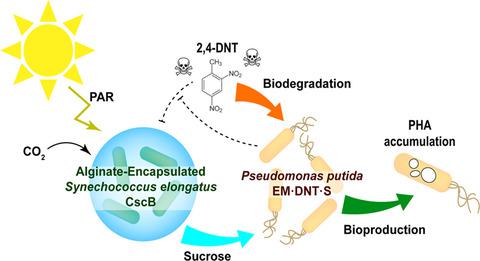当前位置:
X-MOL 学术
›
Microb. Biotechnol.
›
论文详情
Our official English website, www.x-mol.net, welcomes your feedback! (Note: you will need to create a separate account there.)
Biotransformation of 2,4-dinitrotoluene in a phototrophic co-culture of engineered Synechococcus elongatus and Pseudomonas putida.
Microbial Biotechnology ( IF 5.7 ) Pub Date : 2020-02-16 , DOI: 10.1111/1751-7915.13544 Derek T Fedeson 1, 2 , Pia Saake 3 , Patricia Calero 4 , Pablo Iván Nikel 4 , Daniel C Ducat 1, 2, 5
Microbial Biotechnology ( IF 5.7 ) Pub Date : 2020-02-16 , DOI: 10.1111/1751-7915.13544 Derek T Fedeson 1, 2 , Pia Saake 3 , Patricia Calero 4 , Pablo Iván Nikel 4 , Daniel C Ducat 1, 2, 5
Affiliation

|
In contrast to the current paradigm of using microbial mono‐cultures in most biotechnological applications, increasing efforts are being directed towards engineering mixed‐species consortia to perform functions that are difficult to programme into individual strains. In this work, we developed a synthetic microbial consortium composed of two genetically engineered microbes, a cyanobacterium (Synechococcus elongatus PCC 7942) and a heterotrophic bacterium (Pseudomonas putida EM173). These microbial species specialize in the co‐culture: cyanobacteria fix CO2 through photosynthetic metabolism and secrete sufficient carbohydrates to support the growth and active metabolism of P. putida, which has been engineered to consume sucrose and to degrade the environmental pollutant 2,4‐dinitrotoluene (2,4‐DNT). By encapsulating S. elongatus within a barium–alginate hydrogel, cyanobacterial cells were protected from the toxic effects of 2,4‐DNT, enhancing the performance of the co‐culture. The synthetic consortium was able to convert 2,4‐DNT with light and CO2 as key inputs, and its catalytic performance was stable over time. Furthermore, cycling this synthetic consortium through low nitrogen medium promoted the sucrose‐dependent accumulation of polyhydroxyalkanoate, an added‐value biopolymer, in the engineered P. putida strain. Altogether, the synthetic consortium displayed the capacity to remediate the industrial pollutant 2,4‐DNT while simultaneously synthesizing biopolymers using light and CO2 as the primary inputs.
中文翻译:

工程细长聚球藻和恶臭假单胞菌光养共培养物中 2,4-二硝基甲苯的生物转化。
与目前在大多数生物技术应用中使用微生物单一培养物的范例相比,越来越多的努力致力于设计混合物种联合体,以执行难以编程到单个菌株中的功能。在这项工作中,我们开发了一种合成微生物群落,由两种基因工程微生物组成,即蓝细菌(细长聚球藻PCC 7942)和异养细菌(恶臭假单胞菌EM173)。这些微生物物种专门从事共培养:蓝藻通过光合代谢固定CO 2并分泌足够的碳水化合物来支持恶臭假单胞菌的生长和活跃代谢,该恶臭假单胞菌已被设计用于消耗蔗糖并降解环境污染物2,4‐二硝基甲苯(2,4-DNT)。通过将S. elongatus封装在藻酸钡水凝胶中,可以保护蓝藻细胞免受 2,4-DNT 的毒性作用,从而增强共培养的性能。该合成联盟能够以光和CO 2作为关键输入来转化2,4-DNT,并且其催化性能随着时间的推移保持稳定。此外,通过低氮培养基循环该合成聚体促进了工程恶臭假单胞菌菌株中聚羟基脂肪酸酯(一种增值生物聚合物)的蔗糖依赖性积累。总而言之,该合成联盟展示了修复工业污染物 2,4-DNT 的能力,同时使用光和 CO 2作为主要输入合成生物聚合物。
更新日期:2020-02-16
中文翻译:

工程细长聚球藻和恶臭假单胞菌光养共培养物中 2,4-二硝基甲苯的生物转化。
与目前在大多数生物技术应用中使用微生物单一培养物的范例相比,越来越多的努力致力于设计混合物种联合体,以执行难以编程到单个菌株中的功能。在这项工作中,我们开发了一种合成微生物群落,由两种基因工程微生物组成,即蓝细菌(细长聚球藻PCC 7942)和异养细菌(恶臭假单胞菌EM173)。这些微生物物种专门从事共培养:蓝藻通过光合代谢固定CO 2并分泌足够的碳水化合物来支持恶臭假单胞菌的生长和活跃代谢,该恶臭假单胞菌已被设计用于消耗蔗糖并降解环境污染物2,4‐二硝基甲苯(2,4-DNT)。通过将S. elongatus封装在藻酸钡水凝胶中,可以保护蓝藻细胞免受 2,4-DNT 的毒性作用,从而增强共培养的性能。该合成联盟能够以光和CO 2作为关键输入来转化2,4-DNT,并且其催化性能随着时间的推移保持稳定。此外,通过低氮培养基循环该合成聚体促进了工程恶臭假单胞菌菌株中聚羟基脂肪酸酯(一种增值生物聚合物)的蔗糖依赖性积累。总而言之,该合成联盟展示了修复工业污染物 2,4-DNT 的能力,同时使用光和 CO 2作为主要输入合成生物聚合物。


























 京公网安备 11010802027423号
京公网安备 11010802027423号